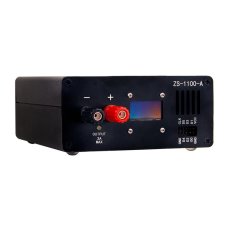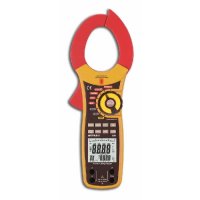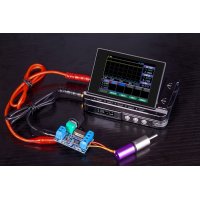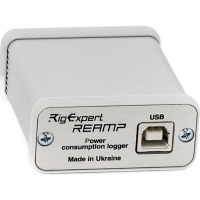Internet of Things is a leading buzzword these days in the technology world. Most of the devices used to create the IoT (Internet of Things) work on small batteries. The measurement of energy consumption of these IoT devices is a difficult task due to the dynamic nature of the current consumption. Developers often need to use multiple instruments and hand calculations to arrive at an estimate of the energy consumption. To solve these problems, the ZS1100A Power Meter has been designed. This tool can plot the current consumption vs time very accurately and in great detail, which can be used along with the battery model to estimate the overall battery life. It has been created by engineers for engineers.
ZS1100A Power Meter - Complete Kit:
along with a power supply, two banana-to-alligator clip cables, eight jumper wires for the front-facing I/O, a USB cable, a flash drive with software, and a quick start guide.
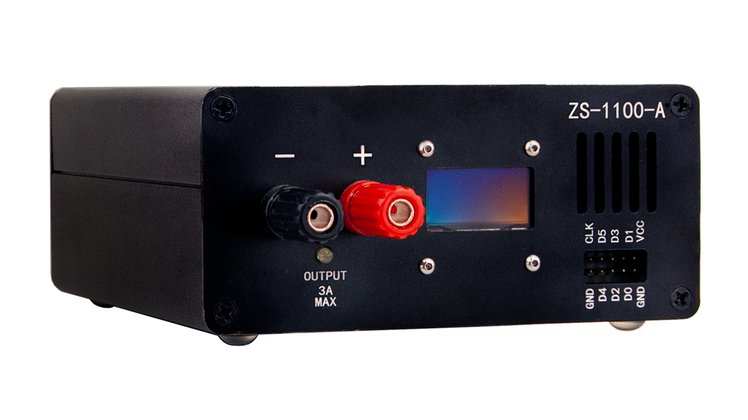
- High Dynamic Range: An IoT device would consume a few μA in sleep state and few hundred mA in its transmit state, depending on the radio. Thus, the current waveform has a very high dynamic range spanning almost 6 decades.
- High Bandwidth: The current drawn by an IoT device can change from few mA to hundreds of mA in couple of micro-seconds. Thus, the frequency content of these current waveforms is well over few 100 KHz.
- Long Profile Times: It is not uncommon for IoT devices to have a typical profile which can last for several tens of minutes to 1 hour. They may perform intermittent wake-ups during this time for some misc activities, and hence these also need to be recorded. For accurate power analysis, complete capture of the profile is needed
Drawbacks of Popular Measurement Methods
Multimeter: Most multimeters use range switching to achieve high dynamic range. While measuring the current, they introduce series resistor and measure the voltage across it. While measuring μA currents, the multimeter would add a few Ωs (may be kΩs) of resistance in series. If the IoT device performs a wake-up during this state, the drop across the high resistor can cause the device to trip and cause system reset. Most multimeters made for this application can record profiles for only few minutes. An IoT current profile can last several tens of minutes and hence the software on the IoT device may need to be modified to account for the limited capture time. Most multimeters do not have a full function GUI to measure various pulse parameters. The multimeters with digitizer options are expensive with retail costs starting at five thousand dollars, and often significantly higher.
Oscilloscope: Using a scope with a current probe is good enough to measure higher currents in idle and transmission modes. The sleep currents, which are of the order of few μA, cannot be measured with this due to the limited dynamic range. It can either measure high currents or low currents at a time. Most scopes use an 8- to 12-bit ADC and this limits the overall dynamic range. The capture length limits apply to most scopes and the overall solution is very expensive - at least few thousand dollars for the probe and tens of thousands for the scope.
These limitations call for a new approach : ZS1100A Power Meter
Demo Wi-Fi Power Profile:

| Parameter | Specification | Notes |
|---|---|---|
| Output Voltage Range | 0 to 6 V | Programmable in 10 mV steps |
| Output Voltage Accuracy | Error of 5 mV max | Measured with 500 mA load |
| Current Measurement Range | -0.5 A to 1.5 A (linear range) | |
| Current Measurement Accuracy | 1% of measured value ± 0.2 μA | After one time self calibration |
| Current Measurement Resolution | < 0.1 μA | |
| Max Output Current | 1 A constant current | Vout = 5.0 V |
| 2 A with 10% duty | Measured with 100 ms pulse for every 1 second | |
| Load Regulation | <0.1% | 0 to 1.5 A |
| Measurement Bandwidth | 300 KHz | 3 dB bandwidth |
| Step Response | 2 μS | 10% to 90% of full range |
| Current Sampling Rate | 1 MHz | |
| Sampling Jitter | 10 ps | RMS jitter |
| Voltage Sampling Rate | Once in every 20 ms | |
| Digital Capture | 6 bits at 1 MSPS | |
| Maximum Capture Length | Tested up to 24 hrs | Limited only by the free space on the HDD |
| Error Rate | < 1e-12 | Less than 1 error in 10^12 samples |
| Or less than one sample error in 24 hours |
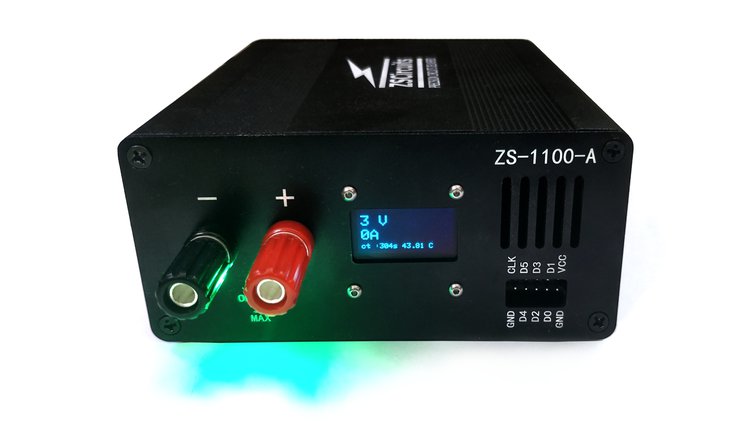
Product Specifications:
- Computer Interfacing: USB 2.0, Type-B connection
- Free GUI with waveform analysis tools (Windows-only for now)
- Data can be exported to sigrok/PulseView for UART, SPI, I²C protocol analysis
- Data can be exported as ASCII in XML
- Excellent data compression rates - 24 hours of data takes ~10 GB
-
I/O: Front-facing pins with standard (2.54 mm/.1") pitch in a 2x5 configuration
-
6 digital inputs
- Function as a logic analyzer capturing at 1 MHz
- Voltage range of 1.8 to 5 V
- Input impedence of 10 pF || 100 kΩ
- 4 have 100 kΩ pull-down resistors
- 2 have 100 kΩ pull-up resistors to VCC
- 2 GND pins (shorted with the power supply ground)
- 1 VCC pin
- 1 CLK output at 1 MHz, 3.3 V, driving a load of 30 pF || 100 kΩ
- 8 jumper wires included with purchase
-
6 digital inputs
- Indicator Screen: OLED - indicating voltage, current, status, etc.
- Electromagnetic Shielding: Aluminum enclosure provides excellent noise reduction
- ESD Protection: On all inputs and outputs
- Thermal Protection: An internal temperature monitor will automatically shut the unit down in case over overheating
-
Environmental Tolerances:
- Operating temperature of 15-40°C
- Operating humidity < 90% RH
Power: Barrel jack, 2.1 mm ID, 5.5 mm OD, with a center-positive
- Input amperage of 5 A max
- Input voltage of 12-15 V DC
-
15 V, 3 A power supply is included with purchase
-
Consumption of < 2 W
-
Dimensions: ~ 16 x 11 x 5 cm (~ 5.9 x 4.3 x 2 in)
-
Weight: ~420 g (.93 lbs)
-
Standard Conformance: CE, FCC, RoHS
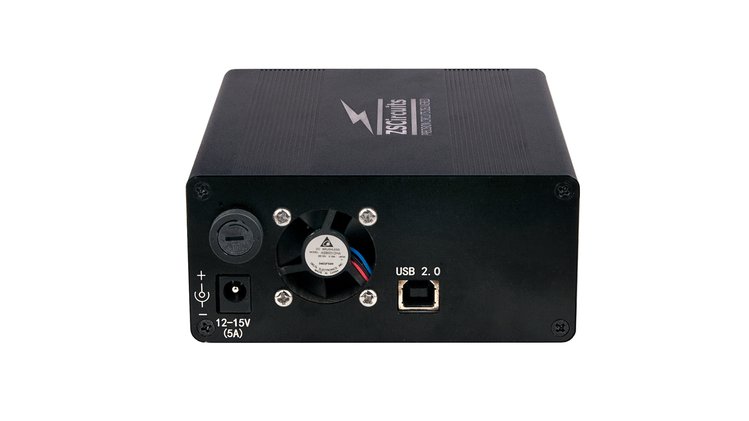
Package Includes:
- 1 x ZS1100A Power Meter
ZS1100A Power Meter
- Brand: Crowd Supply
- Product Code: CS-ZS1100A
- Reward Points: 596
- Availability: Discontinued
-
रo 59,605.00
- Price in reward points: 59605
-
- 2 or more रo 58,087.00
Related Products
Metravi 307N Digital Clamp On Power Meter
4 Digits, Dual LCD, Single Phase and Three Phase, Max /Min / Peak Hold, 55mm Jaw Diameter, T-RMS, AC..
रo 8,850.00 रo 10,005.00
Miniware MDP-XP Smart Digital Power Supply Kit
MDP (Mini Digital Power System) is a system of programmable linear DC power supply based on a modula..
रo 25,104.00 रo 28,690.00
REAMP Power Measurement Tool and logger
When you want to achieve the longest battery life possible, you need an accurate and reliable power ..
रo 5,951.00
Tags: Power Meter, Power supply

